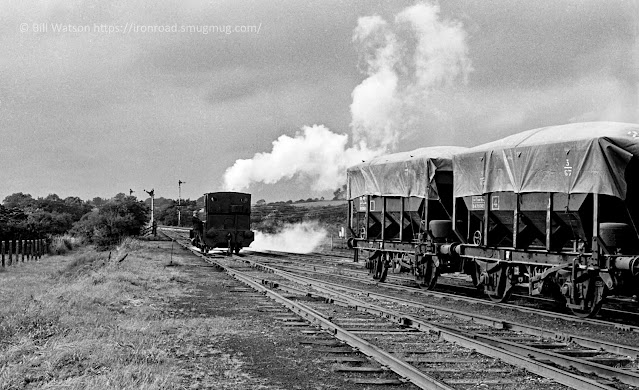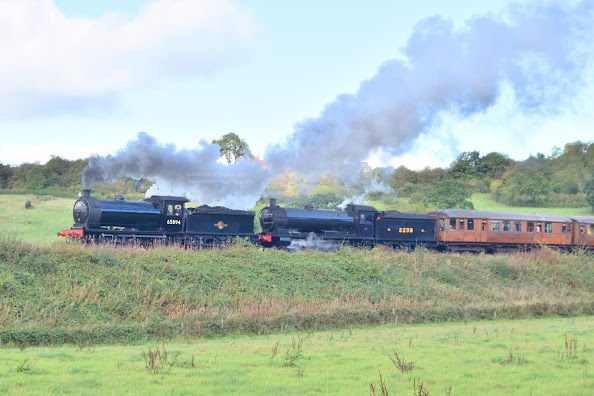Howe & Co Sidings and Cocklakes Works Tramway
Howe & Co Sidings and Cocklakes Works Tramway
History & The Route
Located several miles south of Carlisle lies the site of Howe & Co Sidings and Cocklakes works tramway. The short but steeply graded tramway connected Howe & Co sidings on the famous Settle & Carlisle railway with the Gypsum works at Cocklakes. It was in operation from the 1880s until the 1970s when it was put on "Care & Maintenance" and subsequently closed. However, Gypsum had been mined in the area since the 1680s. But, things did not fully take off till during the second world war when there was an increased demand.
John Howe opened and operated the mines till around 1910 when the Carlisle plaster & Cement company took over. They were later taken over by British Gypsum.
Today the majority of the 1-mile tramway can be walked. And, in places there are some reminders of its previous life as an industrial railway.
Andrew Barclay 0-4-0ST "John Howe" standing in a similar place to where the above photo was taken. An unidentified "type 2" diesel can be seen in the distance heading back towards Kingmoor depot. © Bill Watson
Turning the other way and looking up the steep gradient that once took the tramway away from the sidings and onto the works at Cocklakes. The exchange sidings sat to the left of the pole. The signal box that once controlled the sidings still stands but was hard to photograph. Located on the opposite side of the S&C lay Carlisle Brick & Tile works/ Lonsdale Brick & Tile works. Who had a narrow gauge railway system. Little trace of this remains to this day.
A short train made up of 3 wagons descends the steep gradient into the exchange sidings. Note the signal box just visible behind the last wagon and the man riding in the last wagon!. The locomotive is presumably "John Howe" one of a number of 0-4-0 Andrew Barclay saddle tanks that worked on the line. © Bill Watson
Looking up the trackbed in the direction of Alby lodge and the first level crossing over "Peter Gate".
"John Howe" taken at a similar location to the above photo. © Bill Watson
The trackbed after crossing "Peter Gate" and looking in the direction of the works. This section of trackbed has been tarmacked over and is used as access to a small sewage works.
At the end of the above section of trackbed lies a level crossing with the track still clearly visible. From here the trackbed has returned to farm land and is not accessible. The site of the works is also not accessible. So this was unfortunately as far as I was able to walk. A small quarry and a shaft existed near the location.
Thankfully this superpub picture by Bill Watson shows the works in 1968. No trace of the site remains to this day. The site of the Alabaster shaft is now in use a salvage yard and car dealer. It is also worth noting that there was an extensive underground narrow gauge railway which operated in the mines under the works. The works were also the first place in the UK where Plasterboard was made.
Preserved Locomotives
For a relatively short railway a surprising number of locomotives that worked it have survived into preservation. It is worth noting that as far as I can tell all the locomotives (steam and diesel) that worked on the tramway were built by Andrew Barclay.
John Howe
Built in 1908 as works number 1147. After closure of the works the engine went to Steam town Carnforth and then onto the Ribble steam railway in Preston where it is based today. The above picture was taken at Beamish Museum where it operated during 2014. The engine is currently stored out of ticket at the Ribble steam railway.
J.N.Derbyshire
Geoff Sheppard. This file is licensed under the Creative Commons Attribution-Share Alike 4.0 International licence.
Built in 1929 as works number 1969 by Andrew Barclay. Like John Howe it is now at the Ribble steam railway in Preston. But, also spent time at Steamtown.
Built in 1954 as works number 2361 by Andrew Barclay. It was originally delivered to the companies Long Meg site several miles south of the Cocklakes site. The engine is named after Mr. William Steuart Trimble, the Deputy Chairman of the plaster company. It was moved to Cocklakes as the spare loco in 1969. It stayed there out of use till 1980. It was later moved to the Bowes Railway near Gateshead where the above picture was taken. W.S.T is now out of traffic awaiting an overhaul.
Built in 1968 as a demonstration loco, it arrived at Cocklakes in August 1969. It was later transferred to Long Meg in 1971 but returned to Cocklakes and stayed till rail traffic ended. It moved to the Tanfield railway in 1982 but has since moved again to the Bo'ness & Kinneil railway.
Further viewing
My thanks go to Bill Watson for kindly allowing me to use his images.
If you’ve enjoyed this then please consider supporting this website so that I can continue to deliver new content like this. Patreon and Ko-Fi



















Comments
Post a Comment